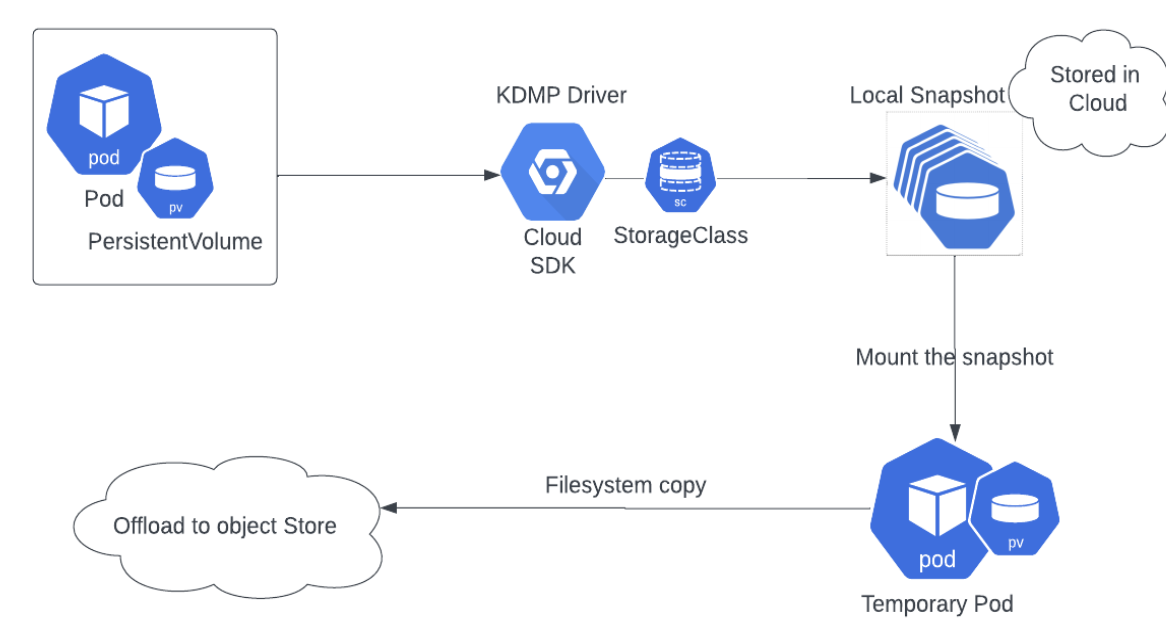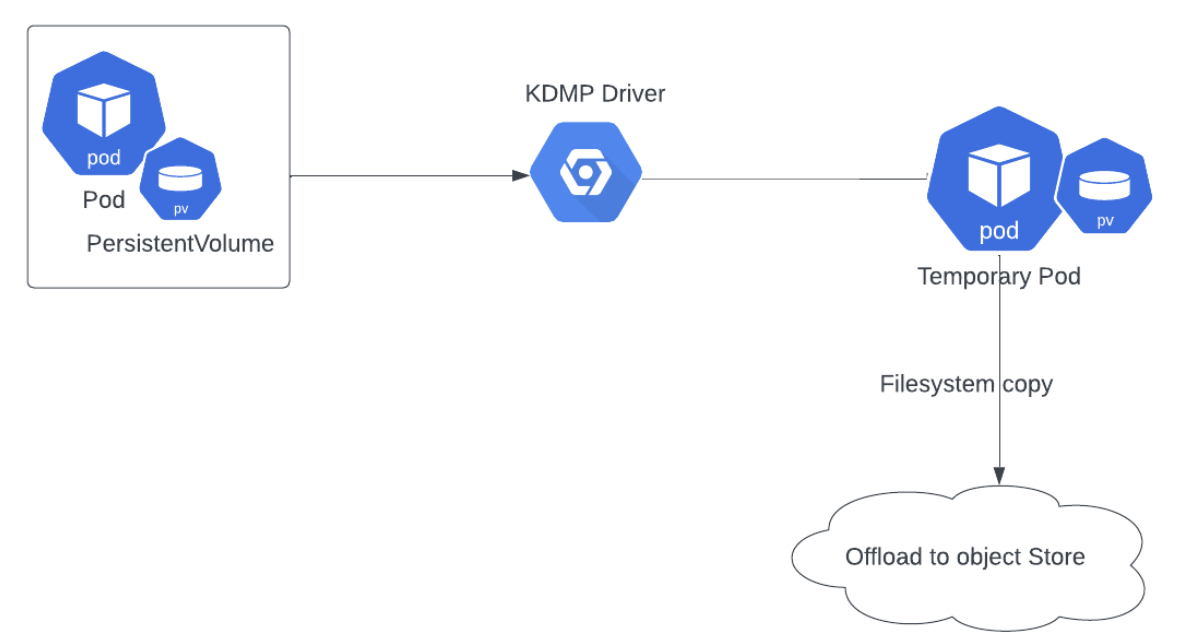KDMP backups
KDMP backups are generic backups that Portworx Backup supports utilizing the KDMP driver. If you have deployed Portworx Backup without Portworx Enterprise, then a KDMP backup get triggered.
If you do not want to use cloud native drivers and prefer to use Portworx Backup's KDMP driver, you need to set the backup type as generic in kdmp-config ConfigMap that resides in kube-system namespace of your application cluster.
KDMP backup types
Portworx backup supports two variants of KDMP backups as outlined in the following sections:
KDMP with local snapshot
In Portworx Backup, KDMP driver takes snapshots and later offloads or uploads these snapshots to S3 compliant object store.
In this case Portworx Backup performs the following tasks:
a. Takes available snapshot storageclass information
b. Creates a snapshot
c. Uses KDMP driver to attach the mount point of the PV on the worker node
d. Copies the file system contents to object storage
Direct KDMP/Generic
In this backup type, Portworx Backup utilizes the KDMP driver to attach the mount point of the PV on the worker node and copies the file system contents to object storage.

When a KDMP backup occurs
Portworx Backup triggers a KDMP backup in the following scenarios:
Portworx Backup without Portworx Enterprise:
a. If the storage provider does not support CSI snapshots
b. If the storage provider supports CSI snapshots and if you want to offload the backup to S3 object store along with the selection of volume snapshot class during creation of backup.
KDMP backup matrix
Following table provides KDMP backup matrix when the storage provider supports CSI snapshot:
| Cloud storage provider | Storage type | Backup mechanism |
|---|---|---|
| AWS | EBS | Cloud-native driver |
| EFS | KDMP with local snapshot | |
| Azure | Disk | Cloud-native driver |
| File share | Direct KDMP | |
| IBM | IBM storage |
|
| GCP | Google disk | Cloud-native driver |
| Google file | Direct KDMP | |
| OCP | OCP storage | Direct KDMP |
Regardless of the storage provider and whether or not the CSI snapshot is supported by these storage providers, if you update the parameter
BACKUP_TYPE: "Generic"in thekdmp-configConfigMap. Refer to this topic to learn more on how to updatekdmp-configConfigMap.For some on premises (for example, Flash Array) or on cloud storage providers without CSI snapshot support, direct KDMP backup gets triggered and the Portworx Backup user interface does not provide Offload to CSI snapshot backup location option. This is the default behavior of Portworx Backup.
Cross-cloud and cross-region backups and restores with Portworx Backup.
Create a KDMP backup
To trigger a KDMP backup for the storage provider that supports CSI snapshot class, ensure that you select the following options in the Create Backup window:
CSI snapshot class
Offload CSI snapshots to backup location
 note
noteOffload CSI snapshots to backup location option appears in the Create Backup window only if the storage provider supports CSI snapshot mechanism.
KDMP-config ConfigMap
Exclude files and directories
Consider a scenario where you have directories or files (hidden, read-only, logs) with different extensions and you wish to exclude those from being included in the backup. Portworx Backup now allows you to exclude such directories or files from being backed up. To exclude or omit such directories and files from being included in the backup, you need to update the kdmp-config ConfigMap with the following steps:
Run the following command to edit the
kdmp-configConfigMap:kubectl edit cm kdmp-config -n kube-system(Optional, execute the following command only if you want direct KDMP backup in cases where it is native CSI or cloud native backup)
Add the following parameter in the data section:
BACKUP_TYPE: "Generic"noteYou must add the above parameter on the source application cluster where you perform backup. It is not mandatory to add the parameter on the destination cluster where you restore.
Add the following key-value pair:
KDMP_EXCLUDE_FILE_LIST: |
<storageclassName1>=<dir-list>,<file-list1>,....
<storageclassName2>=<dir-list>,<file-list1>,....Example
apiVersion: v1
data:
ENABLE_PX_GENERIC_BACKUP: "true"
KDMP_BACKUP_JOB_LIMIT: "5"
KDMP_DELETE_JOB_LIMIT: "5"
KDMP_EXCLUDE_FILE_LIST: |
px-db=dir1,file1,dir2
mysql=dir1,file1,dir2
KDMP_KOPIAEXECUTOR_IMAGE: kopiaexecutor:1.2.10
KDMP_KOPIAEXECUTOR_IMAGE_SECRET: ""
KDMP_KOPIAEXECUTOR_LIMIT_CPU: "0.2"
KDMP_KOPIAEXECUTOR_LIMIT_MEMORY: 1Gi
KDMP_KOPIAEXECUTOR_REQUEST_CPU: "0.1"
KDMP_KOPIAEXECUTOR_REQUEST_MEMORY: 700Mi
KDMP_MAINTENANCE_JOB_LIMIT: "5"
KDMP_RESTORE_JOB_LIMIT: "5"
SNAPSHOT_TIMEOUT: ""
kind: ConfigMap
metadata:
name: kdmp-config
namespace: kube-system
resourceVersion: "7120917"
uid: bd1e505b-0191-414c-aedb-0b1d413d4002You can exclude directories and files from being backed up for both direct KDMP and KDMP with local snapshot backup types. For the latter, you cannot exclude any directories or files from being backed up if the local snapshot already exists even after
kdmp-configConfigMap is updated with the key-value pair specified above. If you want to restore with excluded directories or files, delete the existing local snapshot and then restore the backup.
KDMP backups and restores with large volume PVCs
KDMP job pods consume increased amounts of memory for the large volume PVC backup and restore operations to backup locations. As a result, you may see out of memory alerts or a failure of the kdmp job pods that run on each application or target cluster. During these scenarios, Portworx by Pure Storage recommends to increase the CPU and memory limit related parameters in the kdmp-config ConfigMap which resides in the kube-system namespace on the target cluster or application cluster.
Update the following parameters in kdmp-config ConfigMap to resolve OOM errors:
KDMP_KOPIAEXECUTOR_LIMIT_CPU: "0.4"
KDMP_KOPIAEXECUTOR_REQUEST_CPU: "0.2"
KDMP_KOPIAEXECUTOR_REQUEST_MEMORY: 2Gi
KDMP_KOPIAEXECUTOR_LIMIT_MEMORY: 4Gi
Related topics: